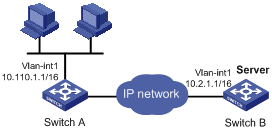- Table of Contents
-
- H3C Low-End and Mid-Range Ethernet Switches Configuration Examples(V1.01)
- 00-1Cover
- 01-Login Configuration Guide
- 02-VLAN Configuration Guide
- 03-GVRP Configuration Guide
- 04-Voice VLAN Configuration Guide
- 05-IP Addressing and Performance Configuration Guide
- 06-QinQ Configuration Guide
- 07-BPDU Tunnel Configuration Guide
- 08-VLAN Mapping Configuration Guide
- 09-MAC Address Table Management Configuration Guide
- 10-Link Aggregation Configuration Guide
- 11-IP Source Guard Configuration Guide
- 12-DLDP Configuration Guide
- 13-MSTP Configuration Guide
- 14-IPv4 Routing Configuration Guide
- 15-IPv6 Configuration Guide
- 16-IPv6 Routing Configuration Guide
- 17-IPv4 Multicast Configuration Guide
- 18-IPv6 Multicast Configuration Examples
- 19-802.1x Configuration Guide
- 20-AAA Configuration Guide
- 21-MAC Authentication Configuration Guide
- 22-Portal Configuration Guide
- 23-ARP Configuration Guide
- 24-DHCP Configuration Guide
- 25-ACL Configuration Guide
- 26-QoS Configuration Guide
- 27-Port Mirroring Configuration Guide
- 28-Cluster Management Configuration Guide
- 29-SNMP-RMON Configuration Guide
- 30-NTP Configuration Guide
- 31-FTP-TFTP Configuration Guide
- 32-UDP Helper Configuration Guide
- 33-Information Center Configuration Guide
- 34-DNS Configuration Guide
- 35-File System Management Configuration Guide
- 36-Remote Upgrade Configuration Guide
- 37-NQA Configuration Guide
- 38-VRRP Configuration Guide
- 39-SSH Configuration Guide
- 40-Port Security Configuration Guide
- 41-Port Isolation Configuration Guide
- 42-LLDP Configuration Guide
- 43-MCE Configuration Guide
- 44-PoE Configuration Guide
- 45-OAM Configuration Guide
- 46-Connectivity Fault Detection Configuration Guide
- 47-RRPP Configuration Guide
- 48-sFlow Configuration Guide
- 49-SSL-HTTPS Configuration Guide
- 50-PKI Configuration Guide
- 51-Track Configuration Guide
- 52-EPON-OLT Configuration Guide
- 53-Smart Link Configuration Guide
- 54-MPLS Configuration Guide
- Related Documents
-
| Title | Size | Download |
|---|---|---|
| 32-UDP Helper Configuration Guide | 47.93 KB |
1 UDP Helper Configuration Guide
Configuring UDP Helper
Sometimes, a host needs to forward broadcasts to obtain network configuration information or request the names of other devices on the network. However, if the server or the device to be requested is located in another broadcast domain, the host cannot obtain such information through broadcast.
To solve this problem, the Ethernet switch provides the UDP Helper function to relay specified UDP broadcast packets. In other words, UDP Helper functions as a relay agent that converts UDP broadcast packets into unicast packets and forwards them to a specified destination server.
With UDP Helper enabled, the device decides whether to forward a received UDP broadcast packet according to its UDP destination port number.
l If the destination port number of the packet matches the one pre-configured on the device, the device modifies the destination IP address in the IP header, and then sends the packet to the specified destination server.
l If not, the device sends the packet to the upper layer protocol for processing.
Network Diagram
Figure 1-1 Network diagram for UDP Helper configuration

Networking and Configuration Requirements
l VLAN-interface 1 on Switch A has an IP address of 10.110.1.1/16 and is connected to network segment 10.110.0.0/16.
l Enable the forwarding of broadcast packets with UDP destination port number 55 to the destination server 10.2.1.1/16.
Applicable Product Matrix
|
Product series |
Software version |
Hardware version |
|
S3610 Series Ethernet Switches |
Release 5301 Release 5303 |
All versions |
|
S5510 Series Ethernet Switches |
Release 5301 Release 5303 |
All versions |
|
S5500-SI Series Ethernet Switches |
Release 1207 |
All versions except S5500-20TP-SI |
|
Release 1301 |
S5500-20TP-SI |
|
|
S5500-EI Series Ethernet Switches |
Release 2102 |
All versions |
|
S7500E Series Ethernet Switches |
Release 6300 |
All versions |
|
S3500-EA Series Ethernet Switches |
Release 5303 |
All versions |
Configuration Procedure
The following configuration assumes that a route from Switch A to the network segment 10.2.0.0/16 is available.
# Enable UDP Helper on Switch A.
<SwitchA> system-view
[SwitchA] udp-helper enable
# Enable the forwarding of broadcast packets with the UDP destination port number 55.
[SwitchA] udp-helper port 55
# Specify the server with the IP address of 10.2.1.1 as the destination server to which UDP packets are to be forwarded.
[SwitchA] interface vlan-interface 1
[SwitchA-Vlan-interface1] ip address 10.110.1.1 16
[SwitchA-Vlan-interface1] udp-helper server 10.2.1.1
Complete Configuration
#
udp-helper enable
udp-helper port 55
#
interface Vlan-interface1
ip address 10.110.1.1 255.255.0.0
udp-helper server 10.2.1.1
#
Configuration Guidelines
l The UDP Helper enabled device cannot forward DHCP broadcast packets. That is, the UDP port number cannot be set to 67 or 68.
l By default, the receiving of directed broadcasts to a directly connected network is disabled on S3610 and S5510 series Ethernet switches. As a result, UDP Helper is available only when the ip forward-broadcast command is configured in system view. If DHCP or NTP broadcast mode is configured on an S3610 or S5510 switch, the switch can receive directed broadcasts. At this time, UDP Helper is available even if the ip forward-broadcast command is not configured. For details about the ip forward-broadcast command, refer to IP Addressing and IP Performance Commands of the related product manual.
l Before specifying UDP port numbers with which packets are to be forwarded, you need to enable UDP Helper; otherwise, an error message is displayed. Disabling UDP Helper also disables the specified UDP port numbers.
